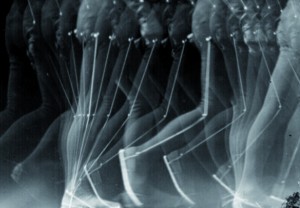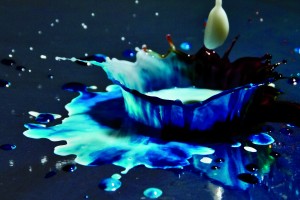MONDAY, 3 MAY 2010
Think of photographs and one thinks of a medium used to freeze a moment for eternity, not to depict motion and capture fleeting movements. Yet photography has been essential in capturing stages of motion that are too transient for us to see. In a unique interplay between the worlds of art and science, the development and modification of photography has allowed us to dramatically slow down time and reveal the imperceptible intricacies of movement in the world around us.Eadweard Muybridge’s famous images of a galloping horse were the first use of photography to capture movement. Muybridge was challenged in 1872 by Leland Stanford, Governor of California, to determine whether all of a horse’s feet are off the ground simultaneously during a gallop. Muybridge used 12 cameras arranged in a straight line alongside the horse’s path; these were set off by the horse triggering electrical contacts as it ran. The resulting pictures proved conclusively for the first time that horses are indeed airborne during the gallop.
Muybridge’s technique became known as chronophotography – ‘picturing time’. It meant that photography was no longer simply a reproductive medium, but could create images that would otherwise never be seen. Chronophotography led to signature images of the swift motions of human and animal bodies. Although Muybridge was not a scientist himself, his technique was soon exploited by those who were.
Etienne Jules Marey, an eminent French physiologist in the late 1800s, was one of the first to use chronophotography for scientific studies. Marey believed that to discover the physical laws of animal locomotion, direct observation of the mechanisms in real time was the key. Slowing or stopping the movement to study it may not provide a true picture of the natural mechanism. When he came to know of Muybridge’s work, he realised that photographs provided a way to study natural movement without this kind of interference.
Not satisfied with Muybridge’s array of separate cameras, Marey developed ways to capture movement with a single camera. He built a photographic gun in which a light sensitive plate was revolved behind the lens. This allowed him to record sequential images at regular intervals of time as small as 1/720th of a second. With this method, he could not only photograph the motion of land animals, but also of birds, since the trigger to record images did not have to be set in the path of motion. But he was not satisfied with the spatial or temporal detail that these sequences gave him. It was a further development of this technique that provided the ability to study movement in greater detail.
Marey developed his technique to capture sequential images in the same frame. As his subject moved, a shutter was rotated in front of a stationary linear photographic plate, repeatedly exposing it at regular intervals. At each exposure, the subject was in a different position, so that the final image revealed the sequence of their movement. The interval between exposures was used to control the overlap in the image and the continuity of the sequence. Although movement was restricted to a straight line, recording consecutive phases of motion in the same frame was a revolution. Not only did this allow visualisation of the physiology of movement, but also directly showed the exact trajectory and distance of movement in a defined time.
To obtain more precise data, Marey photographed indoors in darkness. He dressed his models in black suits with stitched white lines. When homme squellete, or ‘skeleton man’, performed actions, only these white lines reflected light and showed up in the photographs. This reduction of the movement allowed Marey to relate these lines to axes of motion, centres of gravity and lines of force, a previously impossible analysis of natural human movement.
While art can allow even inanimate objects to represent human nature through colours, settings and composition, Marey made the opposite equally true. By reducing the human forms of his models and equating them to a skeleton, he transfigured human subjects into ‘objects’ of scientific experimentation.
Marey’s techniques provided the opportunity to study many physical phenomena in a new way. In association with his assistant Georges Demeneÿ, Marey not only studied many aspects of human locomotion – jumping, walking, running, gait – but also that of animals and the flight of birds. What’s more, he used chronophotography to directly visualise the trajectories traced by balls, the paths taken by swinging strings and wires and the movement of water. He built the first wind tunnel and photographed the movement of wisps of smoke, the first recorded study of air currents.
The significance of the interaction between art and science in motion capture is illustrated by the work of Ottomar Anschütz in the 1880s. Anschütz was not a scientist but a professional artistic photographer in Germany who specialised in chronophotography. He invented fast shutters and laid the foundations for the invention of the kinematograph (motion picture). In fact, when the first kinematograph was shown in Berlin, it was widely considered to be a perfection of Anschütz’s techniques.
Anschütz’s most renowned images, pictures of storks in flight taken in 1884, inspired Otto Lilienthal’s first glider designs. Lilienthal obtained Anschütz’s services to film his flight. The flight was fatal for Lilienthal, but Anschütz’s recording was studied by the Wright brothers, who used it to make significant improvements to the design of their aircraft. Ultimately, Anschütz’s art contributed to the first successful flight of a powered aircraft.
While Anschütz was primarily an artist who’s work benefited science, the scientist Harold Edgerton made significant contributions to art through his work in motion capture. Edgerton invented the stroboscope, a sequential flash device that is used to alter the perceived motion of an object by manipulating the observer’s view. For example, when the frequency of a flashing strobe light synchronises exactly with the frequency of a repeated motion, such as a swinging pendulum, the motion appears to be frozen at one moment.
Although primarily a scientist, Edgerton used the strobe to capture the beauty in everyday phenomena – water running from a tap, drops impacting liquid, golfers in action. His photographs helped to popularise science with the public, who wondered at the inherent beauty of the pictures, thereby making them not only of scientific interest, but also artistic masterpieces.
Chronophotography is all around us today. Films are shown at 24 frames per second, essentially 24 sequential photos presented fast enough for us to perceive movement. High speed filming of sports provides super slow-motion replays, allowing us to see the physics that is otherwise concealed by the speed of the action; the compression of a tennis ball, the bouncing of snooker balls or the devastation of a high-impact racing crash. In industry, chronophotography is used routinely in car crash tests. The cameras used are capable of taking pictures at intervals of 100 picoseconds. The super slow motion shows which parts of the car are most susceptible to stress, and ultimately allows improvements to the car’s safety to be made. Films of industrial processes, such as manufacturing techniques, can also be used as evidence when filing for patents, to prove the uniqueness of the technique.
The development of photography to capture motion shows how the arts and sciences can move together. While both are developed for their own ends, they can interact and influence one another, pushing each other further than they could go alone.
Marey’s and Edgerton’s collections have been digitised and can be found here and here respectively.
Swetha Suresh is a PhD Student in the Department of Pharmacology




